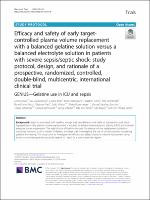Efficacy and safety of early target-controlled plasma volume replacement with a balanced gelatine solution versus a balanced electrolyte solution in patients with severe sepsis/septic shock: study protocol, design, and rationale of a prospective, randomized, controlled, double-blind, multicentric, international clinical trial
Resum
Paraules clau
Col·loides; Gelatina; Sèpsia
Citació recomanada
Marx G, Zacharowski K, Ichai C, Asehnoune K, Černý V, Dembinski R, et al. Efficacy and safety of early target-controlled plasma volume replacement with a balanced gelatine solution versus a balanced electrolyte solution in patients with severe sepsis/septic shock: study protocol, design, and rationale of a prospective, randomiz. Trials. 2021 Jun 2;22:376.
Audiència
Professionals
Empreu aquest identificador per citar i/o enllaçar aquest document
https://hdl.handle.net/11351/6789Aquest element apareix a les col·leccions següents
- HVH - Articles científics [2966]
Els següents fitxers sobre la llicència estan associats a aquest element:

